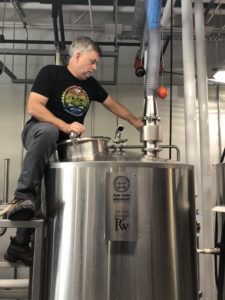Brewer’s Spotlight: Dave Colt, Sun King Brewing Company
We sat down with Dave Colt, co-founder and head brewer of Sun King in Indiana, and discussed the symphony that is beer, the culinary-like combinations you find, and experimentals.

Our “Brewer’s Spotlight” is a series of conversations with innovative brewers across the country. Recently we sat down with Dave Colt, co-founder and head brewer of Sun King in Indiana, and we discussed the symphony that is beer, the culinary-like combinations you find, and experimenting with experimentals.
Could you talk a little bit about Sun King and the types of beers you brew?
 Dave: Sun King has been around for about nine years now, and I’ve been brewing professionally for 22, so we make pretty much everything under the sun. (Sorry…Sun King…I just got that…that was unintentional.) Anyway, our philosophy is, no matter what kind of beer we’re producing—especially hoppy beers—we want it to be eminently quaffable. We want people to not just get through a pint, but to go, “Wow—that was awesome! I need another.”
Dave: Sun King has been around for about nine years now, and I’ve been brewing professionally for 22, so we make pretty much everything under the sun. (Sorry…Sun King…I just got that…that was unintentional.) Anyway, our philosophy is, no matter what kind of beer we’re producing—especially hoppy beers—we want it to be eminently quaffable. We want people to not just get through a pint, but to go, “Wow—that was awesome! I need another.”
As you’re thinking about formulating beers and how they will come together, what role do hops play?
Dave: I think about making a beer like you’re making chili. Or, maybe, creating a symphony is a better analogy. Every component plays a part. In this case, hops bring that extra special timpani (or kettle drum beat) over the top. It’s just an important factor, because, much like grapes, hops have a way of expressing the way conditions change year after year more than any other ingredient—how much it rained, how much sunshine there was—they’re very expressive.
Have you ever been surprised by unexpected flavors that have come through from hops?
Dave: Absolutely, the first time I had Amarillo®. There was this bright, ruby red grapefruit kind-of-thing happening. I was so struck that I designed a beer specifically for it and it’s probably the most popular IPA we produce. It’s called Grapefruit Jungle and it features Amarillo prominently, along with a couple of other hops in support.
When I’m thinking about hops, usually we don’t do a single malt, single hop SMASH beer. Instead, we like to put combinations of things together and bring highlights out of certain hops. In this instance, we add some Centennial, for that nice orangey, baby aspirin kind-of-thing going on, and little bit of Simcoe® to rough it up. When you pair that with Amarillo, it’s like biting through a grapefruit without peeling it, so you’re getting the zest and everything.
Do you have a culinary background? The way brewers describe flavors is very much like chefs.
I don’t have a culinary background, except that I grew up in my grandmother’s kitchen. I’m a foodie. I think that the very best brewers are the ones who know their way around a kitchen; they’re food focused and food centric. I could go to their house and know I’m going to get a fantastic meal.
What are some of the oddest flavors you’ve explored while brewing?
We’ve made some really fun Brett beers with hops, which are a bit less common. We made one called Hop Up Offfa That Brett—and it’s this hop-forward sour, with nice citrus notes and the brett strains that we selected for these great pineapple notes. The zestiness of the American hops that we used (Cascade being one of them) brought the whole thing together. The freshness. You know, if you’re making marinara, you can’t have it without having basil and oregano and all that good stuff in there, otherwise you just have tomato soup.
We made a beer with an experimental hop, HBC 472, I think it was, with the bourbon coconut note. That note just struck me, so we made a beer specifically for it . To punch up that “bourboniness”, we used some oak staves to help bring it all together. It’s stuff like that when you say, “Wow, I just didn’t know a hop could taste like that!”
Are there any emerging flavor trends that you’re interested in?
There’s a whole subsection of pastry beers where people are cramming donuts into mash tuns and stuff like that is pretty interesting. Sours are getting more and more momentum and we’re trying to figure out how hops can play in that area. Lactobacillus and hops don’t like each other at all, meaning the lacto doesn’t like to grow and populate in the presence of hops because it has that antiseptic quality. When the beer’s finished, we’re trying to bring back in that freshness by dry hopping those styles of beer.
Are there any hops that you particularly like?
We love playing with experimental hops. We have a pretty robust lab here, so we can drill down to some nitty gritty analysis. And our sampling program, our QC program, is pretty top notch, as well. We really enjoy checking out those experimentals. Citra® was one of them that we played with years ago—now everyone uses it because it’s so fantastic. It’s exciting. It’s inspirational.
It’s one of those things—going back to the coconut bourbon hop—when I was out in the field in Yakima smelling it and tasting it, all these ideas started running through my mind, imagining which beers it would be fantastic for. The first swing we took with it was a hefeweizen, just to check out how coconut would play with the banana and clove flavor in a hef. It really gets your juices flowing, your creativity, and keeps things from being stagnant—and allows for different interpretation of traditional styles with new hop varieties.
